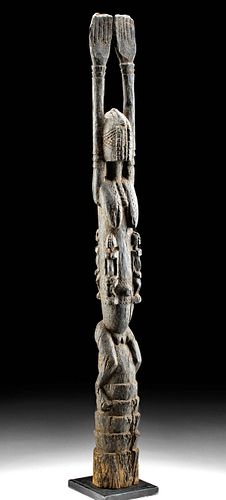Tall 19th C. African Dogon Wood Figure - C14 Tested
Lot 235
About Seller
Artemis Gallery
686 S Taylor Ave, Ste 106
Louisville, CO 80027
United States
Selling antiquities, ancient and ethnographic art online since 1993, Artemis Gallery specializes in Classical Antiquities (Egyptian, Greek, Roman, Near Eastern), Asian, Pre-Columbian, African / Tribal / Oceanographic art. Our extensive inventory includes pottery, stone, metal, wood, glass and textil...Read more
Categories
Estimate:
$10,000 - $15,000
Absentee vs Live bid
Two ways to bid:
- Leave a max absentee bid and the platform will bid on your behalf up to your maximum bid during the live auction.
- Bid live during the auction and your bids will be submitted real-time to the auctioneer.
Bid Increments
| Price | Bid Increment |
|---|---|
| $0 | $25 |
| $300 | $50 |
| $1,000 | $100 |
| $2,000 | $250 |
| $5,000 | $500 |
| $10,000 | $1,000 |
| $20,000 | $2,500 |
| $50,000 | $5,000 |
| $100,000 | $10,000 |
| $200,000 | $20,000 |
About Auction
By Artemis Gallery
Mar 24, 2022
Set Reminder
2022-03-24 10:00:00
2022-03-24 10:00:00
America/New_York
Bidsquare
Bidsquare : Exceptional Antiquities Ethnographic Fine Art
https://www.bidsquare.com/auctions/artemis-gallery/exceptional-antiquities-ethnographic-fine-art-9057
Museum-worthy examples of classical antiquities (Egyptian, Greek, Roman, Near Eastern), Viking, Far East / Asian, Pre-Columbian, African / Tribal, Oceanic, Native American, Spanish Colonial, Fossils, Ancient Jewelry, Fine / Visual Arts, so much more! Artemis Gallery info@artemisgallery.com
Museum-worthy examples of classical antiquities (Egyptian, Greek, Roman, Near Eastern), Viking, Far East / Asian, Pre-Columbian, African / Tribal, Oceanic, Native American, Spanish Colonial, Fossils, Ancient Jewelry, Fine / Visual Arts, so much more! Artemis Gallery info@artemisgallery.com
- Lot Description
West Africa, Central Mali, Bandiagara, Dogon peoples, ca. late 19th to early 20th century CE. A marvelous and massive wooden sculpture, impressively hand-carved to display a female figure seated atop a tiered pillar with 4 smaller figures lining her torso. Depicted nude, the fascinating female stretches her lengthy arms above her head and holds her fingers together. Her elongated body features short, bent legs, large, pendulous breasts, delineated genitalia, and a protruding navel, suggestive of pregnancy. Incised geometric and zigzag designs adorn her face, breasts, and torso, while a beaded necklace hangs between her breasts and several armbands embellish her wrists and biceps. A group of 4 petite female figures horizontally line her torso, each standing on bent legs and presenting prominent breasts, an abstracted visage, a slender torso, long arms, and hands resting at the groin. Size: 4.6" W x 45.2" H (11.7 cm x 114.8 cm); 46.2" H (117.3 cm) on included custom stand.
The Dogon people inhabit the rocky heights of Mali's Bandiagara Escarpment. Wooden figures, such as this example, are traditionally created for shrines and depict the spirits responsible for the fertility of both the land and the Dogon people, such as the family’s real and mythical ancestors, women who have died in childbirth, and water spirits. These sculptures were traditionally used to petition higher powers for sustenance and new life. According to the Metropolitan Museum of Art, "Dogon sculpture is primarily concerned with the spirits responsible for the fertility of both land and people. These include a family's real and mythical ancestors, the souls of women who died in childbirth, and water spirits. While the exact functions and meanings of individual works often remain obscure, scholars agree that Dogon sculptures were created for shrines. The most distinctive subject rendered by Dogon sculptures is that of a single figure standing with raised arms. This posture has usually been interpreted as a gesture of prayer—an effort to link earth and heavens—and it has been suggested that it may represent an appeal for rain."
Dogon sculptures, like this example, have historically been made only by professional artisans. A few select families within each village specialize in sculpture; it is believed that mystical powers allow them to deploy earth, air, and fire to make such pieces. Note the rich patina throughout this piece. According to Giulia Paoletti, Andrew W. Mellon Curatorial Postdoctoral Fellow at the Metropolitan Museum of Art, "Among the Dogon the patina played the role of receptacle for nyama, or life force. Without this substance and its ritual appliance, the statue would be a mere piece of wood devoid of any protective power. The patina thus becomes a crucial component in appreciating this sculpture and its ceremonial significance."
This piece has been tested using radiocarbon dating (C-14) analysis and has been found to be ancient and of the period stated. A full report will accompany purchase.
Provenance: private Jersey City, New Jersey, USA collection
All items legal to buy/sell under U.S. Statute covering cultural patrimony Code 2600, CHAPTER 14, and are guaranteed to be as described or your money back.
A Certificate of Authenticity will accompany all winning bids.
PLEASE NOTE: Due to recent increases of shipments being seized by Australian & German customs (even for items with pre-UNESCO provenance), we will no longer ship most antiquities and ancient Chinese art to Australia & Germany. For categories of items that are acceptable to ship to Australia or Germany, please contact us directly or work with your local customs brokerage firm.
Display stands not described as included/custom in the item description are for photography purposes only and will not be included with the item upon shipping.
#169910Several fissures throughout, as well as expected nicks, chips, and abrasions, commensurate with age. Some light softening of incised detail. Otherwise, intact and excellent with lovely patina and nice earthen deposits in recessed areas.Condition
- Shipping Info
-
All shipping is handled in-house for your convenience. Your invoice from Artemis Gallery will include shipping calculation instructions. If in doubt, please inquire BEFORE bidding for estimated shipping costs for individual items.
-
- Buyer's Premium



 EUR
EUR CAD
CAD AUD
AUD GBP
GBP MXN
MXN HKD
HKD CNY
CNY MYR
MYR SEK
SEK SGD
SGD CHF
CHF THB
THB














